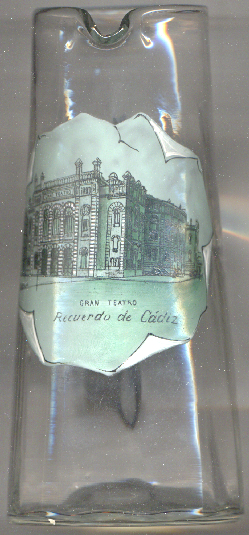

|
| ESPAÑA | Spain |
| Andalucía | Andalusia |
| provincia: Cádiz |
 Cádiz, the capital of the province of Cádiz in the autonomous community of Andalusia, is situated
on a promontory that juts out into the Bay of Cádiz, which is a small part of the Gulf of Cádiz.
The municipality has a population of about 116,000 (2019).
Cádiz, the capital of the province of Cádiz in the autonomous community of Andalusia, is situated
on a promontory that juts out into the Bay of Cádiz, which is a small part of the Gulf of Cádiz.
The municipality has a population of about 116,000 (2019).
Founded around 1104 BC as Gadir or Agadir by Phoenicians from Tyre, Cádiz is mostly regarded as the most ancient city still standing in Western Europe. The Phoenicians established a port in the 7th century BC. The city fell under the sway of Carthage after the First Punic War (264–241 BC). Cádiz became a depot for Hannibal's conquest of southern Iberia, and he sacrificed there to Hercules/Melqart before setting off on his famous journey in 218 BC to cross the Alps and invade Italy. Later the city fell to Romans under Scipio Africanus in 206 BC. Under the Roman Republic and Empire, the city flourished as a port and naval base known as Gades. The overthrow of Roman power in Hispania Baetica by the Visigoths in 410 saw the destruction of the original city, of which there remain few remnants today. The site was later reconquered by Justinian in 551 as part of the Byzantine province of Spania. It would remain Byzantine until in 572 it was reconquered by the Visigothic Kingdom. Under Moorish rule between 711 and 1262, the city was called Qādis, whence the modern Spanish name was derived. In 1262 it was conquered by Alphonso X of Castile. During the Age of Exploration, the city experienced a renaissance. Christopher Columbus sailed from Cádiz on his second and fourth voyages and the city later became the home port of the Spanish treasure fleet. Consequently, it became a major target of Spain's enemies. In the 18th century, the sand bars of the Guadalquivir forced the Spanish government to transfer its American trade from Sevilla to Cádiz, which now commanded better access to the Atlantic. Although the empire itself was declining, Cádiz now experienced another golden age from its new importance. It has been a principal home port of the Spanish Navy since the accession of the Spanish Bourbons in the 18th century. The loss of the Spanish overseas colonies was a severe blow to Cádiz's trade. After 1900, the outdated port structure was modernized. In recent years, the city has undergone much reconstruction.
The  Gran Teatro Falla [left, no. 3946] stands on the foundations of
the previous Gran Teatro de Cádiz, a wooden building that had been built in 1871 but had burned in 1881. Construction
of the new theatre began in 1884, following a design in Neo-Mudejar style drawn by the architect Adolfo Morales de los
Ríos. In 1886 the city government took over direction of the project, which proceeded only intermittently due to lack
of funds. The theatre was completed in 1905. Municipal architect Juan Cabrera de la Torre made significant modifications to
Morales's original plans. The theatre was known as the Gran Teatro until 1926 when it was renamed for composer and
native son Manuel de Falla.
Gran Teatro Falla [left, no. 3946] stands on the foundations of
the previous Gran Teatro de Cádiz, a wooden building that had been built in 1871 but had burned in 1881. Construction
of the new theatre began in 1884, following a design in Neo-Mudejar style drawn by the architect Adolfo Morales de los
Ríos. In 1886 the city government took over direction of the project, which proceeded only intermittently due to lack
of funds. The theatre was completed in 1905. Municipal architect Juan Cabrera de la Torre made significant modifications to
Morales's original plans. The theatre was known as the Gran Teatro until 1926 when it was renamed for composer and
native son Manuel de Falla.
[https://de.wikipedia.org/wiki/C%C3%A1diz, https://en.wikipedia.org/wiki/C%C3%A1diz;
https://en.wikipedia.org/wiki/Gran_Teatro_Falla]
![[scale]](lineal.jpg)